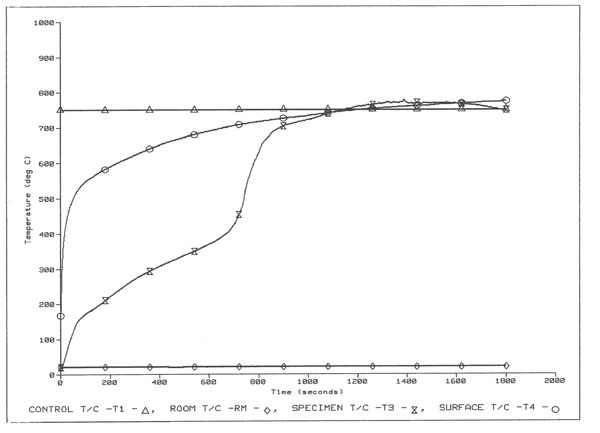Fire Testing
Understanding the ASTM E136 Test for Assessing Combustibility of Materials
The International Building Code (IBC) and International Residential Code (IRC) prescribe the ASTM E136 fire test for assessing the combustibility of materials.
ASTM E136 uses a vertical tube furnace to expose building materials to a temperature of 750° C (1382°F). While actual building fire exposure conditions are not duplicated with this test method, it helps indicate materials that don’t aid combustion or add appreciable heat to an ambient fire.
The ASTM E136 test is particularly important in construction, where the use of non-combustible materials is essential for reducing the risk of fires and limiting their potential to cause extensive damage.
What Is the ASTM E136 Test?
The ASTM E136 test is a standardized testing procedure developed by ASTM International to assess the combustibility of materials when exposed to high temperatures.
This test helps determine whether a material can be classified as noncombustible, meaning that it does not contribute to the spread of fire and does not readily catch fire when exposed to flames or high heat.
Materials that pass the ASTM E136 test demonstrate:
- Minimal flame spread
- No significant smoke production
- An overall resistance to catching fire
It's important to note that the ASTM E136 test may not fully replicate all potential fire scenarios that could occur in the real world. While passing the test is an important indicator of a material's noncombustibility, it's recommended to consider additional tests and real-world evaluations when making comprehensive fire safety decisions.
How the NGC Testing Services Team Conducts ASTM E136
The ASTM E136 test involves subjecting a test specimen of the material to rigorous conditions that simulate a fire scenario. The specimen is exposed to a high-temperature environment, and its reaction to heat and flame is carefully monitored and evaluated.
The test aims to determine whether the material ignites, how quickly it ignites, and the extent to which it contributes to flame spread and smoke production.
When we conduct an ASTM E136 fire rating test at NGC Testing Services, small test specimens (1.5′′ by 1.5′′ by 2.0′′ ± 0.1′′) are first instrumented with two thermocouples: one placed on the specimen's outside surface and the other placed inside the specimen, at its appropriate geometric center.
Then, the instrumented specimen is placed into our facility’s vertical tube furnace set at 750° C.

A material is considered to pass (i.e., classified as non-combustible) if three of four test specimens meet ASTM E136 requirements for weight loss, temperature rise, and flaming.
ASTM E136 Limitations and Considerations
While ASTM E136 is a valuable tool for assessing the combustibility of materials, it's important to recognize the test’s limitations and consider additional factors when evaluating a material's overall fire safety:
- Controlled testing environment: ASTM E136 noncombustible materials are evaluated under controlled laboratory conditions that may not fully replicate the complex and varied fire scenarios that can occur in real-world settings. Factors such as wind, different fuel sources, and varying fire intensities might impact a material's behavior differently than what is observed in the controlled test.
- Single ignition source: The test employs a single ignition source to assess a material's response to fire. However, real fires can have multiple sources of ignition, which might lead to different outcomes for certain materials.
- Isolated specimens: In real-world scenarios, materials often interact with one another, potentially affecting fire behavior. The ASTM E136 test evaluates individual material specimens in isolation, which might not reflect how materials behave when combined in a building assembly.
- Complementary tests: To gain a comprehensive understanding of a material's fire performance, it's advisable to consider additional fire testing. These tests might include assessments of heat release rate, flame spread, and smoke production.
- Variability in results: Different testing laboratories, equipment, and procedures can lead to variations in test results. This emphasizes the importance of using accredited laboratories and following standardized procedures to ensure consistent and accurate assessments.
Forging Fire Safety With ASTM E136
ASTM E136 plays a pivotal role in facilitating the creation of safer buildings and structures, but it's important to acknowledge the test's limitations. To ensure a comprehensive evaluation of fire safety, working with an experienced and fully accredited testing facility is crucial.
For more than 55 years, NGC Testing Services has conducted efficient and cost-effective full-scale fire testing for materials of all types, and we’re equipped to handle your testing too.
To learn more about the ASTM E136 fire test or other services, contact us today.
This post was originally published in September 2021 by Bob Menchetti and was updated and republished in September 2023.
Search blog articles
Browse by topic
Subscribe for updates
LEARN MORE
Related Blog Articles
GET IN TOUCH
Contact Us
NGC Testing Services features one of North America's most comprehensive and unique fully accredited testing facilities. Contact us today to visit our 50,000-plus-square-foot facility located in Buffalo, New York.

